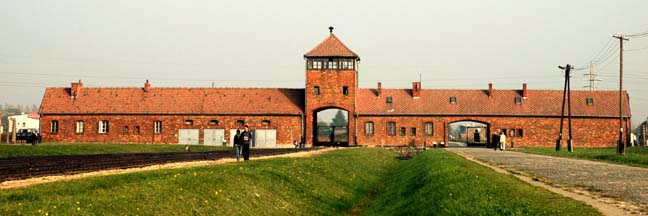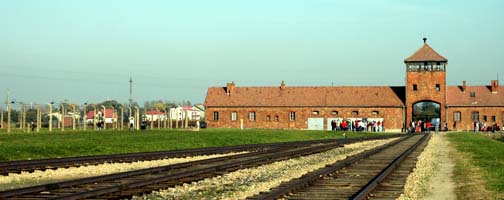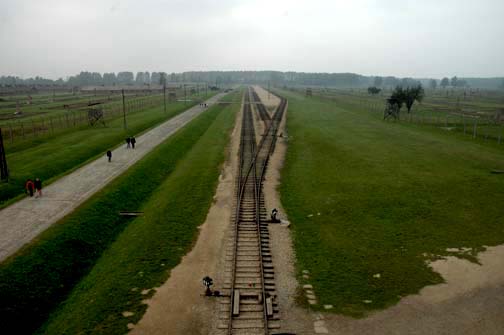The Gate House at Birkenau

The gate house taken
from inside the Birkenau camp
The photo above shows the gate house
which is the main entrance into Birkenau, also known as the Auschwitz
II concentration camp. Beginning around the middle of May 1944,
freight trains that were 40 to 50 cars long rolled through this
gate, day and night, bringing thousands of Hungarian Jews to
be gassed at the four Birkenau gas chambers. The prisoners called
it the "Gate of Death."
 The Gate of Death
The Gate of Death
The gate house was built in 1943, long
after the Birkenau camp was first opened. The first inmates,
who were Soviet Prisoners of War, arrived at Birkenau on October
7, 1941. At first, the gate shown in the photo above was for
trucks and pedestrians. Railroad tracks were not laid through
the gate until the Spring of 1944, just before transports of
Hungarian Jews began to arrive. According to the Auschwitz Museum,
434,351 of these Hungarian Jews were not registered at Birkenau;
instead, they were gassed immediately upon arrival. At the height
of the deportation of the Hungarian Jews, during a 10 week period,
up to 12,000 Jews were gassed and burned each day.
The gate house was remodeled with additions
on each side including a new pedestrian gate. The photo below,
taken outside the camp, shows the pedestrian gate which is on
the left-hand side, as you face the gate house.
 View of the Birkenau
gate house outside the camp
View of the Birkenau
gate house outside the camp
The photo above shows a cornfield to
the right in the foreground. New houses have been built very
close to the former camp and Polish farmers have made use of
the fields right in front of the gate house. Note that the corn
is ready to be harvested, but it did not grow to be "as
high as an elephant's eye."
The sign outside the gatehouse says that
the villages of Brzezinka, Babice, Broszkowice, Rajsk, Plawy,
Harmeze, and Brzeszcze-Budy were torn down to provide space for
the 425-acre Birkenau camp.
The photo below shows modern houses built
very recently just outside the former death camp, the place where
over a million Jews were murdered and their ashes thrown into
several small ponds.
 The gate house with
modern houses on the left
The gate house with
modern houses on the left
In the photo above, students are gathered
in front of the four wide doors into the restrooms. There is
also a display board at this spot which tells the basic history
of Birkenau.
Both sides of the gate house are identical.
When Stephen Spielberg made the movie, Schindler's List, he filmed
scenes of actors exiting from a train which was outside the camp,
but it looked like the train was inside the camp.
The photo below shows the railroad siding
inside the camp, called the ramp, where the Jews exited from
the trains and the selection process took place. Those who were
fit for work were allowed to live for a few months, until they
inevitably died of disease or overwork. The others were sent
immediately to one of the four gas chambers at the far end of
the camp. The gas chambers in Krema II and Krema III were at
the end of the main camp road, which is shown on the left in
the photo below. The railroad tracks
extend about a mile into the camp, all the way to the gas chambers
II and III; some of the Hungarian Jews were immediately gassed
without going through a selection process, even though the Nazis
were desperately in need of workers for their munitions factories.
This photo was taken in the early morning, looking west from
the gate house tower.
 Ramp where Jews went
through selection process
Ramp where Jews went
through selection process
The gate house at Birkeanu is located
three kilometers, or about two miles, from the main Auschwitz
camp, known as Auschwitz I. To get to the Birkenau camp from
the main camp, turn right after exiting from the parking lot.
The road curves to the left and goes over the railroad overpass
where Reichsführer Heinrich Himmler stood on March 1, 1941
when he selected the village of Birkenau to be the location of
a new addition to the Auschwitz camp. At that time, the invasion
of the Soviet Union and the plan to exterminate all the Jews
in Europe was only months away.
From the overpass, the road leads directly
to the Gate of Death. The railroad
spur line that goes through the gate house begins on the left
side of the gate, about a quarter of a mile away, and curves
around until it forms a straight line in front of the gate. Trains
coming from the west entered the Birkenau camp from tracks on
the left side of the gate, as you are facing it, and did not
pass the railroad station in the town of Auschwitz. Trains coming
from the opposite direction passed the train station in Auschwitz
and then entered the camp on the spur line. The train tracks
end only a few yards from two of the gas chambers inside the
Birkenau camp.
The town of Auschwitz was a major railroad
hub, with many train tracks coming into it, and a large marshaling
yard near the Auschwitz station. Standing on the railroad overpass
in 1941, Himmler realized that Birkenau was an ideal location
for transporting people by rail from all over Europe, although
the plans for exterminating the Jews were not finalized until
the Nazis were confident that they would win their war against
the Soviet Union.
|